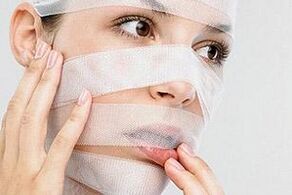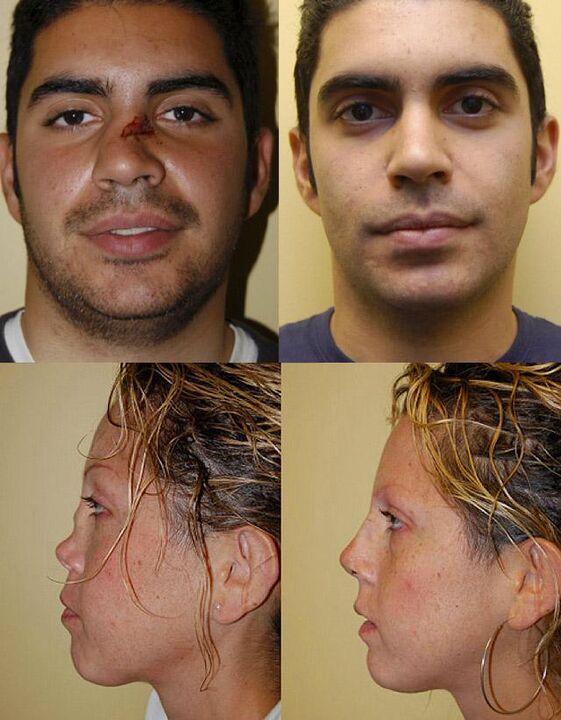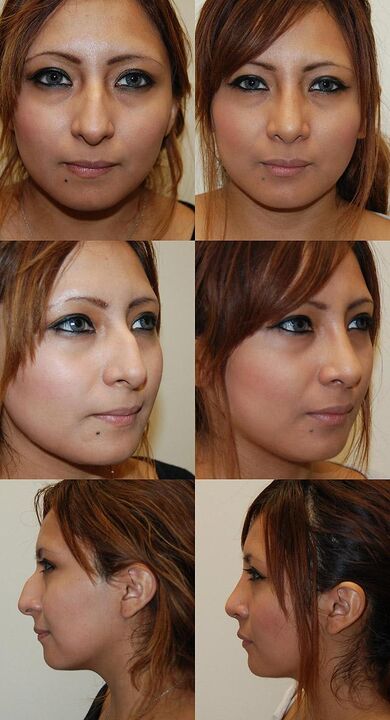
Rhinoplasty (nasal plastic surgery) is the correction, restoration, correction of the structures of the nose using plastic surgery techniques. Used for medical and aesthetic reasons.
Despite its prevalence, nose correction surgeries are still considered one of the most difficult.
Nose repair surgeries have been performed for thousands of years. Ancient manuscripts bear witness to the successful experience of such procedures long before our era.
Medicine has taken a step ahead of ancient physicians, and modern rhinoplasty is more of a cosmetic procedure than a medical necessity.
Indications for rhinoplasty
Each plastic surgery is a complex creative process that combines the problems of solving aesthetic problems with the preservation or restoration of specific functional characteristics of the organ (in this case, it is nasal breathing).
Thus, rhinoplasty can be performed for therapeutic and aesthetic purposes. The optimal age for it is 25 to 35 years old.
The medical indications are:
- congenital deformation of the nasal septum;
- polyps and hypertrophy of the turbinates;
- traumatic injuries and post-traumatic changes in bones, cartilage, physiological (due to uneven development of tissues) or compensatory of the nasal septum;
- pronounced violation or complete absence of the possibility of nasal breathing.
Changes in the correct anatomical structure of the nose are very often the cause of functional disorders and pathological conditions - shortness of breath, atrophy or hypertrophy of the nasal mucosa, rhinosinusitis, otitis media, frequent respiratory diseases, night snoring.
In addition, in children, such defects can cause chronic oxygen deprivation of the brain, which leads not only to their physical, but also mental retardation, and affects their mental development and behavioral reactions. Therefore, rhinoplasty can also be performed on children under the age of 18.
Over 60% of the reason for rhinoplasty is the patient's desire to improve the shape of the nose to achieve complete harmony in its appearance. The services of a plastic surgeon are increasingly popular. The aesthetic indications for rhinoplasty can be divided into two main groups:
- goal - these are disproportionate and unattractive sizes or shape of the nose;
- subjective, or psychological: there are no specific criteria for evaluating beauty, each person has their own established stereotype, and therefore, for simply personal reasons, they may not like their nose.
These reasons often affect the professional and personal relationships of people, give rise to complexes of dissatisfaction and their own inferiority, especially in the female environment, leads to social maladjustment.
Rhinoplasty for aesthetic purposes is indicated in cases where there is:
- disproportionate size of the nose in relation to the entire face - too large or, conversely, too small;
- congenital or acquired malformations;
- curvature of the nasal septum;
- dilated nostrils, lump;
- forked, lowered or too raised, asymmetrical tip, as well as its mismatch with the height of the nasal dorsum;
- saddle shape;
- aesthetically unsatisfactory result of the previous operation.
In many cases, the medical and aesthetic indications are the same and result from the same anatomical defects.

Types of rhinoplasty
In accordance with the goal pursued and the technique for performing the surgical intervention, rhinoplasty is divided into:
- Reconstructive, the purpose of which is to restore anatomical disorders resulting from improper intrauterine development, injuries or traumatic diseases.
- Aesthetics - correction of existing defects.
According to the same criteria, there are several types of rhinoplasty:
- Reduction or enlargement of the nose.
- Backrest alignment - correcting a saddle sag or removing a lump.
- Correction of aesthetic imperfections of the tip.
- Correction of the septum (septoplasty).
- Post-traumatic reconstruction of the structure.
All types of operations are subdivided into:
- primary;
- secondary;
- say again.
Access techniques
When performing a rhinoplasty, depending on the access options, the following techniques are used:
- Closed rhinoplasty,in which incisions can take place in the nasal cavity. Closed access is subdivided into marginal (along the inner surfaces of the wings of the nose), transeptal, inter- and transchondral. After the incision, the soft tissues are separated (separated) from the cartilage and bones that make up the frame, which allows you to freely perform the necessary manipulations. Closed rhinoplasty is less traumatic than open rhinoplasty and eliminates arterial damage and tissue malnutrition, and postoperative scars are completely invisible, as they are located in the nasal cavity. It is most often used, especially for cosmetic rhinoplasty.
- Open rhinoplasty- the incision passes along the columella (cutaneous part of the fold between the nasal openings) and on the wings of the nose at their junction with the lip. The technique is used in cases that do not allow the task to be accomplished in another (closed) way. It allows to lift the soft tissues and cartilage upwards, to have sufficient access to the internal parts of the nose and to perform manipulations under constant visual control. Open rhinoplasty is necessary to correct especially serious changes and technically complex and important operations - pronounced deformation of the nose, especially with lateral displacement; combination of a deformity of the nose with deformities such as "cleft lip" or a cleft hard palate; reconstruction using grafts. The downside of open rhinoplasty is the formation of a visible postoperative scar, as well as forced damage to the arteries of the columella, resulting in significant and lasting postoperative tissue edema.
Rhinoplasty of any type is performed under one of the types of general anesthesia and usually lasts 1 to 2 hours. Sometimes their duration can reach three hours or more.
How is rhinoplasty performed?
The operation is carried out in the following order:
- correction of the nasal septum is carried out;
- if necessary, the shells of the nose are reduced;
- the nasal bump is corrected if it is necessary to form a regular profile;
- the bones are dissected and moved to narrow the pyramid of the nose;
- straightens the nose;
- tip correction.
Revision rhinoplasty
A nose replasty is considered if there has already been surgery in this area. The final formation of the nose after plastic surgery occurs in six months to 1 year. This period is optimal for a reoperation. It is carried out when:
- condition of inability to achieve the goal in one step;
- unsatisfactory results of the primary operation;
- the need to correct the problems that remain after the primary rhinoplasty.
According to global statistics, 25-30% of patients who have had primary rhinoplasty require a second corrective surgery. This is considered normal. It usually lasts no more than half an hour and is performed under local anesthesia. Revision corrective rhinoplasty corrects scar deficiencies and brings the shape of the nose to an aesthetic result that will meet the needs of both the surgeon and the patient.
It is much more difficult to perform repeated rhinoplasties in case of a poorly executed or unfavorable primary course of the rehabilitation period, which often depends on the individual characteristics of the organism and complications. Such operations require more careful consideration and more in-depth preparation. They represent a full-fledged plastic according to one of the options, but, as a rule, they turn out to be much more complicated and time-consuming. Minor defects in repeated plastic surgeries can lead to a permanent break in the shape, not only, for example, of the tip, but also a pronounced deformation of the entire nose.
Complications and preparation for surgery
Plasty of the nose is considered one of the most difficult plastic surgeries, the result of which depends largely on the skills and experience of the surgeon. Complications occur in 4 to 15% of cases. They can be during surgery (bleeding, skin ruptures, tearing of the mucocartilaginous flap, violation of the integrity of the bone pyramid, fracture of the bone site, etc. ) and postoperative.
Possible complications after rhinoplasty:
- functional - atrophic rhinitis, difficulty breathing through the nose, loss of smell, temporary or permanent decrease or complete loss of skin sensitivity of the nose and upper lip;
- aesthetic - no change or worsening of previous impairments;
- psychological - patient dissatisfaction with the results of plastic surgery;
- infectious - prolonged swelling and inflammation, suppuration;
- pigmentation of the skin of the nose, formation of a vascular system, adhesions of the mucous membrane and rough scars;
- recurrent nosebleeds and necrosis of soft tissue or cartilage.
Preparation consists of:
- Consultation with a plastic surgeon, during which the technical possibilities to meet the wishes of the patient are determined.
- Carrying out general studies - clinical and biochemical blood tests, blood coagulation test (coagulogram), general urine analysis, tests for hepatitis, HIV, syphilis (RW), ECG.
- Carrying out (if necessary) special studies - images of the paranasal sinuses, endoscopic examination of the nasal cavity in order to identify concomitant abnormalities and pathological changes.
- Computer simulation that allows the patient to compare the initial state of the nose with the results of a future rhinoplasty.
- Consultations with a therapist and specialized specialists (in the presence of chronic diseases).
- Examination by an anesthetist after all examinations.
- Refusal two weeks before the operation to take drugs that affect the processes of blood clotting - acetylsalicylic acid and its analogues, anticoagulants.
- Stop taking sedatives and sleeping pills on the day of the operation.
Contraindications and rehabilitation
Absolute contraindications to rhinoplasty:
- the presence of any chronic systemic disease in severe form (endocrine, cardiovascular, pulmonary);
- acute infectious diseases;
- blood clotting disorders;
- days of menstruation.
Basic recovery after rhinoplasty lasts up to 3 weeks. However, nevertheless, the term for the complete end of the rehabilitation period, when the results are evaluated, is determined by the doctor and is 6 to 12 months. During this period, certain restrictions must be observed.
After 1 to 1. 5 weeks after the operation, the cast and sutures are removed. During the first two weeks, do not wash with hot water or take hot baths, as bleeding, bruising and swelling can occur and spread to the entire face and neck. It is necessary to sleep only on your back in an elevated position, which helps ease breathing and reduce swelling. In dusty areas, it is advisable to wear a face shield. Avoid bending and lifting weights.
In addition, within 3 months you should stop using glasses and wearing tight or heavy hats. You cannot visit the pool and sunbathe for 3 months. In hot weather and in the sun, an umbrella or a wide-brimmed hat is recommended.
When planning rhinoplasty options, an experienced surgeon adheres to the principles of three types of restrictions: restrictions determined by the surgeon himself; restrictions imposed by the patient; restrictions associated with the patient's condition and the anatomical features of his nose.



Price
The cost of the operation depends on the complexity of the correction.
Testimonials
Opinion of a woman
"I always had complexes because of the shape of my nose. It was too long, with a bump and the tip of the nose seemed to bifurcate. Last year I decided to do a rhinoplasty. If I have it. had done earlier, then my life would be now, Probably better. They removed all the blemishes. They even restored the septum, which I didn't even know the flaw. My nose is perfect, and so am I. "
Criticism of a man
"After breaking my nose several times, my nasal septum shifted. I couldn't breathe normally, I snored profusely at night. The diagnoses showed temporary breath while I was sleeping. The nose looked ugly. , it was moved to one side. I had a rhinoplasty to straighten my nose and get rid of the problems with moving the septum. I did it. I am happy with the result. Now my nose is normal, as beforefractures. He's still breathing and I don't snore anymore. "
Rhinoplasty is not always a whim, but more often it is justified by an objective necessity. It is important to choose a competent surgeon and to make sure that you have no contraindications to the procedure.




















